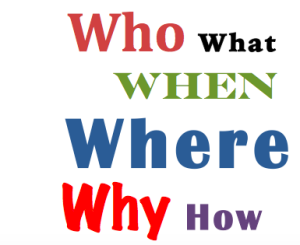
All writing is storytelling, whether it’s a quick email or a memo or a longer report. How we open a story is critical to engaging the reader because we compete for the reader’s limited time.
Journalists are taught to think in terms of the 5 Ws and an H. Who, What, When, Where, Why and How. One of those elements is always the most important of the story, or the lead, and the dominant element changes depending on the essence of the story. The remaining elements need to be addressed as early in the narrative as practical so we don’t lose the reader.
Let’s consider a lead paragraph like this, which is the beginning of a story to pitch a product:
Before you run an errand in your car next time, wouldn’t you like to know that along the way there would be no traffic, no dawdling drivers, no orange cones, and no stop signs slowing you down from completing your appointed tasks? Being able to move through life, including work life, without diversions, distractions and barriers would be a happy life indeed.
At this point, 62 words in, the reader is not sure what the story is about, nor why it should be of interest to them. And, as we’ve discussed in previous posts, the reader never comes to a narrative expecting to be questioned, particularly in the lead sentence.
The narrative continues: But, unfortunately, the road we travel is typically filled with unexpected delays and detours to slow us down, and that includes the road to getting better marketing results.
This type of opening falls into the category of creating a metaphorical or scene set to introduce the story. Such a literary device has its use and place in healthy writing. But, too many writers use (and overuse) it routinely believing it makes the narrative more friendly, inviting and approachable. The problem in the quick click world of online is whether the reader will hang around long enough to get to the essence of the story. The move-on mentality of the reader extends to print as well.
By contrast, let’s take a look at the lead paragraph of a story published in Becker’s Hospital Review:
IBM Watson Health plans to acquire Truven Health Analytics for $2.6 billion, a deal which upon completion will aggregate health-related data of approximately 300 million patient lives.
The Who and What of the story are answered immediately in the first 28 words of narrative engagement. We also find out How much and How many. The reader could quit reading at this point and have a complete story. Those who want more could read on to learn When, Where and Why. The point of any narrative is to deliver the message as powerfully and efficiently as possible.
More importantly, the way we tell our narratives communicates a message to the reader about our brand, personal or corporate. Are we focused? Is our story compelling enough to command the reader’s time? Are we overloaded with jargon and fluff? Is the narrative authoritative? Does our writing tone align with the identity we want to project?
In our experience, a focus on healthy writing as a strategy is rarely something we spend enough time on. In marketing we invest considerable time, energy and money in developing the look and feel of our brand, but precious little time on the strategic thinking, writing, editing and reworking of the accompanying words. Weak narratives can lose the reader and undermine the brand regardless of how interesting our artwork, design or logo might be.
We all have personal brands as well and our professional credibility is published daily in our emails, memos and reports. Like our wardrobe, writing is an outward expression that communicates a powerful message about us by style and substance. How do you and your team look?